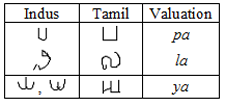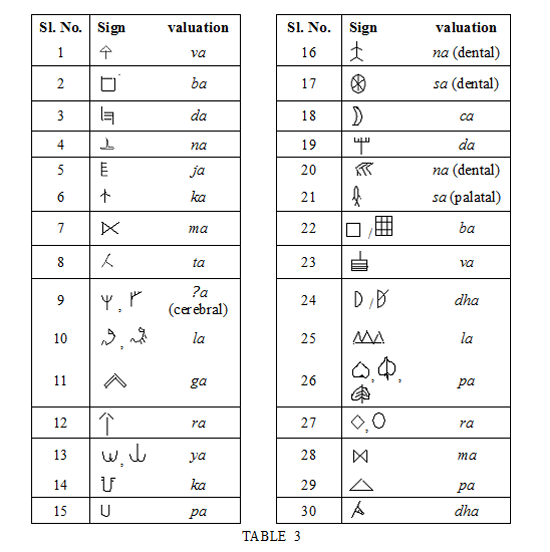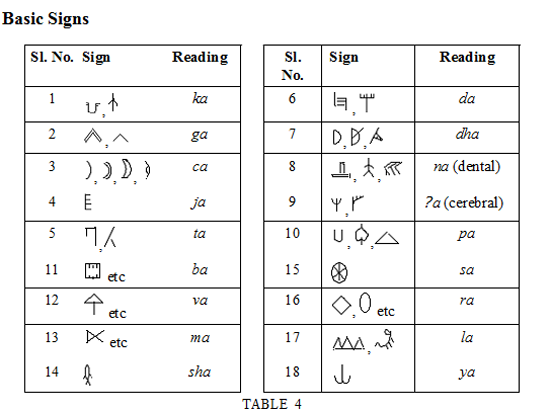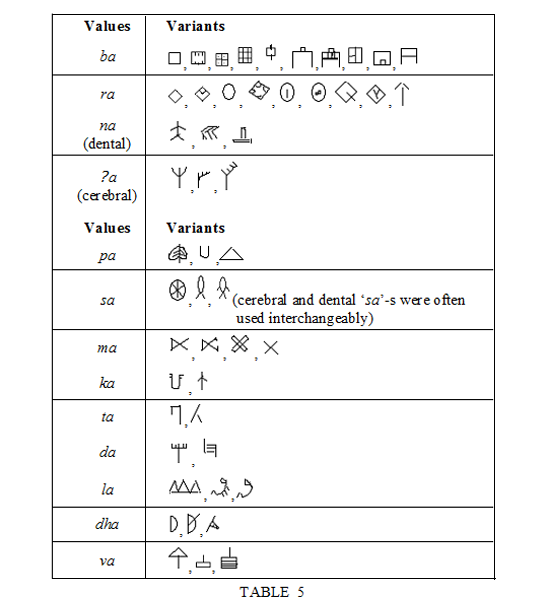Apr 20, 2024
Apr 20, 2024
by Rajat K Pal
Continued from "A New Light on the decipherment of Indus-Saraswati Script"
Not Rebus But Acrology
Acrology is the study for determining a symbol which is used to represent phonetically the initial sound (syllabic or letter) of the name of an object. As for example, 'A' is the first sound of Greek Alpha. It is the method of getting the letter from a pictogram, through phonogram and logogram. By this process, the first phoneme of the phonogram becomes the sign value of that pictogram.

A vessel found in Mohenjodaro. The upper thick portion to observe
(pic. From Harappa site)
1. Sign ![]() : This is a picture of vessel. Many historians have earlier tried to identify it as vessel and the side strokes as its handle. But not a single vessel found in Harappa and Mahenjodaro which has handle. So some critics are not ready to take it as vessel. Here the strokes at the upper portion is assumed as the thick round border at the neck of the vessel, which we find in clay potteries.
: This is a picture of vessel. Many historians have earlier tried to identify it as vessel and the side strokes as its handle. But not a single vessel found in Harappa and Mahenjodaro which has handle. So some critics are not ready to take it as vessel. Here the strokes at the upper portion is assumed as the thick round border at the neck of the vessel, which we find in clay potteries.
All the Indo-Aryan languages have at least a word close to the Early-Aryan word ‘kumbha’ or ‘kalasa’ which means vessel. In Telugu it is called ‘kundalu’, in Tamil it is ‘kutam’, in Bengali it is ‘kalsi’. Moreover in Satali the word ‘kan.da’ means ‘a pot of certain shape and size’. In Pali also there is a word ‘kuta’ which possesses the same meaning.
Kumbha or kalasa is an ancient Indian word which Indian people in every provinces use in various ways even after thousands of years. Acrologically the first letter ‘ka’ became the meaning of the sign to the inhabitants of Indus.
The outward shape of the U or V shaped Indus sign suggests ‘pot’ as its ‘pictorial meaning’. A contextual clue suggests that the ‘intended meaning’ also is ‘vessel’ or more exactly ‘sacrificial or offering vessel’. - Parpola- Study of the Indus Script, Tokyo, 2005
2. Sign ![]() : This is also a pictogram of a vessel or container. This picture is similar to the old Indian word ‘paatra’. This word also is found in other present Indian languages. Through acrology this sign got the representation of letter ‘pa’
: This is also a pictogram of a vessel or container. This picture is similar to the old Indian word ‘paatra’. This word also is found in other present Indian languages. Through acrology this sign got the representation of letter ‘pa’
In Kusana and Gupta inscriptions we find an almost similar sign which also accepted as ‘pa’ by scholars.
 3. Sign
3. Sign ![]() : This man like sign has a definite similarity with the picture it shows. The earlier meaning of this sign was the famous Aryan word ‘Nara’, which means man. Later it came to ‘na’ only (acrology).
: This man like sign has a definite similarity with the picture it shows. The earlier meaning of this sign was the famous Aryan word ‘Nara’, which means man. Later it came to ‘na’ only (acrology).
4. Sign ![]() : This sign is of sun and/or wheel of a chariot. Sun i.e. surya and shakata (=chariot) have both the beginning letter ‘s’/ ‘sh’. This sign is definitely ‘sa’. Like Brahmi Indus did not have specific uses of palatal, dental and cerebral ‘s’-s. This sign is often used to depict the phonetic values of both sa (dental) and sha (palatal) on different occasions.
: This sign is of sun and/or wheel of a chariot. Sun i.e. surya and shakata (=chariot) have both the beginning letter ‘s’/ ‘sh’. This sign is definitely ‘sa’. Like Brahmi Indus did not have specific uses of palatal, dental and cerebral ‘s’-s. This sign is often used to depict the phonetic values of both sa (dental) and sha (palatal) on different occasions.
5. Sign ![]() : candra i.e. the moon is the main pictogram. We get the letter ‘ca’ from this.
: candra i.e. the moon is the main pictogram. We get the letter ‘ca’ from this.
6. Sign ![]() : daaru i.e. tree is the phonogram or pictogram. From this logogram we get this letter ‘da’.
: daaru i.e. tree is the phonogram or pictogram. From this logogram we get this letter ‘da’.
7. Sign ![]() : nadi (= river ) was the original phonogram . We get the letter ‘na’ from this. This sign had a regional use. It was not used by all in the Indus-Saraswati Civilization.
: nadi (= river ) was the original phonogram . We get the letter ‘na’ from this. This sign had a regional use. It was not used by all in the Indus-Saraswati Civilization.
 8. Sign
8. Sign ![]() : The fishlike sign is the most referred sign in the arena of the decipherment of Indus script. Parpola, Mahadevan and many others have discussed this sign in the light of Dravidian languages. I find the valuation of this sign as ‘sha’. In any Sanskrit Dictionary (Monnier- Williams or anyother) we can find a word ‘shalka’ which means ‘scale of a fish’. Thereafter a word derived as ‘shalkalin’ or ‘shalkin’ which means ‘a fish’. Primarily this word meant ‘any water- animal which has shalka or scale’. Later it became only fish (contraction of meaning). Much later words like ‘matsa’ derived and the use of the word ‘shalkin’ almost abolished. From that word ‘shalkin’ the letter ‘sha’ (palatal s) came.
: The fishlike sign is the most referred sign in the arena of the decipherment of Indus script. Parpola, Mahadevan and many others have discussed this sign in the light of Dravidian languages. I find the valuation of this sign as ‘sha’. In any Sanskrit Dictionary (Monnier- Williams or anyother) we can find a word ‘shalka’ which means ‘scale of a fish’. Thereafter a word derived as ‘shalkalin’ or ‘shalkin’ which means ‘a fish’. Primarily this word meant ‘any water- animal which has shalka or scale’. Later it became only fish (contraction of meaning). Much later words like ‘matsa’ derived and the use of the word ‘shalkin’ almost abolished. From that word ‘shalkin’ the letter ‘sha’ (palatal s) came.
 There is another possibility of this sign to get the valuation of ‘sha’ (according to Chakraborty). There is another Sanskrit word ‘shaphari’ , which means ‘a small fish’ by Monnier-Williams and ‘a small kind of card’ by Carl Coppeller in their Sanskrit-English Dictionaries. So ‘shaphari’ is a word which means ‘fish’. From this early phonogram the sign got the valuation as ‘sha’. Rao also accepted it as ‘s’. He took the Rigvedic word ‘Shakula’(which is a variety of fish) for that valuation (Acrophonic Principle).
There is another possibility of this sign to get the valuation of ‘sha’ (according to Chakraborty). There is another Sanskrit word ‘shaphari’ , which means ‘a small fish’ by Monnier-Williams and ‘a small kind of card’ by Carl Coppeller in their Sanskrit-English Dictionaries. So ‘shaphari’ is a word which means ‘fish’. From this early phonogram the sign got the valuation as ‘sha’. Rao also accepted it as ‘s’. He took the Rigvedic word ‘Shakula’(which is a variety of fish) for that valuation (Acrophonic Principle).
The plain fish sign probably has the intended meaning ‘fish’ on Indus tablets, Mesopotemian ‘economic text’ often speaks of fish, but fish is never mentioned in Mesopotemian seal inscriptions. – Parpola, 50th ICES, Tokyo, 2005
Fish appears to have been an important protein source for some population of the Harappan civilization – Belcher, Page 118, 1991.
 9. Sign
9. Sign ![]() /
/ ![]() : In ancient civilizations land was the most precious property. Mainly kings were landowners. The kings were called ‘bhupati’ in India. This sign came from the ‘bhu’, which means land’ and through acrology its valuation became ‘ba/bha’.
: In ancient civilizations land was the most precious property. Mainly kings were landowners. The kings were called ‘bhupati’ in India. This sign came from the ‘bhu’, which means land’ and through acrology its valuation became ‘ba/bha’.
In the dictionary compiled by Apte the word ‘varga’ has various meanings. One of which is a square sign. From the word ‘varga’ this valuation of ‘ba’ might have derived. (Monnier- Williams also stated the meaning of the word ‘varga-ghana’ is ‘the square of a cube’).
 10. Sign
10. Sign ![]() : According to B.B. Chakraborty the valuation of this sign came from the Sanskrit word ‘vahitra’ which means ‘oar’ and colloquially called ‘vaitha’. First letter of the word ‘vahitra’ being ‘va’, the valuation of the sign became ‘va’ through acrology.
: According to B.B. Chakraborty the valuation of this sign came from the Sanskrit word ‘vahitra’ which means ‘oar’ and colloquially called ‘vaitha’. First letter of the word ‘vahitra’ being ‘va’, the valuation of the sign became ‘va’ through acrology.
11. Sign ![]() /
/ ![]() : The valuation of this sign is ‘da’/’dha’. The origin of this sign is the word ‘dhanuka’ which means bow with or without arrow. Through acrology the first letter ‘dha’ became the valuation of that sign.
: The valuation of this sign is ‘da’/’dha’. The origin of this sign is the word ‘dhanuka’ which means bow with or without arrow. Through acrology the first letter ‘dha’ became the valuation of that sign.
12. Sign ![]() : This sign is like a cradle which locally is called ‘dola’ or ‘dolna’. The first letter of this word is ‘da’. The method of acrology is also applicable here.
: This sign is like a cradle which locally is called ‘dola’ or ‘dolna’. The first letter of this word is ‘da’. The method of acrology is also applicable here.
13. Sign ![]() which Parpola has often depicted as
which Parpola has often depicted as ![]() : This sign is the pictograph of wave. In Sanskrit the word ‘lahari’ means a large wave. First letter of this word is ‘la’. Through acrology from the word ‘lahari’ the value of that sign became ‘la’.
: This sign is the pictograph of wave. In Sanskrit the word ‘lahari’ means a large wave. First letter of this word is ‘la’. Through acrology from the word ‘lahari’ the value of that sign became ‘la’.
Same may be said regarding ![]() sign.
sign.
14. Sign ![]() ,
, ![]() ,
, ![]() : There is absolutely no doubt that these are the pictures of leaves. In Sanskrit the word ‘patra’ means leaf. Through acrology the first letter ‘pa’ became the value of that sign.
: There is absolutely no doubt that these are the pictures of leaves. In Sanskrit the word ‘patra’ means leaf. Through acrology the first letter ‘pa’ became the value of that sign.
15. Sign ![]() : ‘dhvaja’ means flag. This flag was an important identification of a renowned person or place. Initially this sign meant ‘dhvaja’. Through acrophonic method the value of this sign became ‘dha’ and/or ‘da’.
: ‘dhvaja’ means flag. This flag was an important identification of a renowned person or place. Initially this sign meant ‘dhvaja’. Through acrophonic method the value of this sign became ‘dha’ and/or ‘da’.
16. Sign ![]() ,
, ![]() etc. : Lands or ‘kshetra’ with specific boundary was the possession of the groups of people in ancient civilizations. Later the head of the group i.e. the king became the owner of lands. The area of that land could be increased or decreased through battles or other ways (gift etc). At that time land was the symbol of monarchy. Land and ‘raajan /raaja’ became synonyms this way. From there the value of that signs became ‘ra’.
etc. : Lands or ‘kshetra’ with specific boundary was the possession of the groups of people in ancient civilizations. Later the head of the group i.e. the king became the owner of lands. The area of that land could be increased or decreased through battles or other ways (gift etc). At that time land was the symbol of monarchy. Land and ‘raajan /raaja’ became synonyms this way. From there the value of that signs became ‘ra’.
To denote king or ‘rajan’ ![]() ,
, ![]() signs and their variants were used with different determinatives(
signs and their variants were used with different determinatives( ![]() ,
, ![]() etc).
etc).
The sign with several modified forms of ‘covered area’ is still found in various prominent scripts through the ages. It is also found in present Indian scripts also.
| Lanuguage | Sign ra |
| Telegu | |
| Sinhala | |
| Sarada | |
| Oria | |
| Gurumukhi | |
| Old Kannada | |
| Kannada | |
| Malayalam | |
| Bengali | |
| Assamese etc | etc |
Table 1
17. Sign ![]() : This sign came from the phoneme ‘mridanga’ , a type of musical instrument, through acrology. This type of instrument was very much in practice at the time of Indus civilization.
: This sign came from the phoneme ‘mridanga’ , a type of musical instrument, through acrology. This type of instrument was very much in practice at the time of Indus civilization.
18. Sign ![]() : This is a picture of hill or mountain, which in Indian language called ‘parbata’ or ‘paahaad’. From the word ‘parvata’ through acrology the meaning of this sign came ‘pa’. This sign with horizontal strokes inside denotes ‘paa’ (
: This is a picture of hill or mountain, which in Indian language called ‘parbata’ or ‘paahaad’. From the word ‘parvata’ through acrology the meaning of this sign came ‘pa’. This sign with horizontal strokes inside denotes ‘paa’ (![]() ).
).
Some valuations as we have detected in present and earlier part are found in many present Indian languages with slight modification, where the initial forms we get in the Indus-Saraswati script is the basis.
| Lanugage | Sign ga | Sign ba |
| Indus | ||
| Kadamba | ||
| Kalinga | ||
| Old Kannada | ||
| Kannada | ||
| Malayalam | ||
| Oria | ||
| Sarada | ||
| Sinhala | ||
| Telegu |
Table 2
It is widely accepted that Tamil script had an intermediate stage by the name of Tamil-Brahmi (Mahadevan has remarkable works on it). As I have mentioned Brahmi, the descendant of Indus-Saraswati script, the same rule should be followed here. Though there is a popular belief that Tamil had an early script of its own, till date no such script is found. Tamil-Brahmi is the earliest found (2nd-3rd century B.C.) script in case of any Dravidian language.
Indus-Saraswati being the father of all Brahmi scripts, Tamil-Brahmi script followed the pattern of it. Even the modern Tamil alphabet still contains some of the Indus –Saraswati signs with the same phonetic valuations.
 Other Dravidian scripts like Telugu, Kannada and some of the old scripts like Kadamba still carry the Indus-Saraswati bearings in letters like Ga(
Other Dravidian scripts like Telugu, Kannada and some of the old scripts like Kadamba still carry the Indus-Saraswati bearings in letters like Ga(![]() ), Ra(
), Ra(![]() ) etc. with slight modifications.
) etc. with slight modifications.
• Panini and Katyayana had referred ‘yavana lipi’ – which is loosely translated as ‘script of the Greeks’, but the period of Panini is before the advent of Greeks. We thus can decide that a script was there which was not as pure as Sanskrit or Aryan. That might have been used by mleccha people.
• Gautama Buddha prohibited members of his order from playing a children’s ‘lettering game’, where ‘letters are traced in the air, or on a play-fellow’s back’. By this example we can decide that writing script was there at the time of Gautama Buddha.
• In Indus- Saraswati script we have few signs with frequent uses, but few signs have very rare (1 or 2) usages. Parpola in his essay at Tokyo session, 2005 has said, “The Chinese writing system has a very large number of signs that are rarely used in newspapers. All ancient scripts, but especially the logo-syllabic ones, had their rare signs”
Basic Indus Signs and Their Phonetic Values

Seal & its impression
Metropolitan Museum of Art, New York
Sri Subhas C. Kak( in 1985) in his essay ‘On decipherment of the Indus Script – A Preliminary study of its connection with Brahmi’ has discussed the concept of basic signs and other compound signs. According to him 39 characters are basic signs in Indus Script. He has identified the following signs as basic signs;

In 1996 S.R. Rao (Dawn & Devolution of the Indus Civilization) has stated that late levels of mature Harappa culture and Lothal, Harappa Culture had omitted all pictures of papal leaf, field, scorpion, hill and animals and retained only the cursive signs. This fact was corroborated further by the simplified cursive inscriptions on the Jhajjar seal and jar from Rojdi.
Subsequently (1965) Dales brought to light 26 seals from the late levels of Mohenjodaro in which all signs were cursive except a ‘field’ sign. Excavation of Dales in later period (1987-88) in Harappa also proved the facts. Here also the field sign was found.
According to Rao there were 24 basic cursive signs in the inscriptions of the late phase of Harappa culture and 34 (out of which 10 were alternate signs for the same phonetic value) signs (basic cursive) in the mature Harappa culture. He also took 28 other pictorial and ideographs used in the Mature Harappa Culture, which totalled to 62 basic signs. Following are some examples which Rao had considered as basic signs;
![]()
We shall have a look at the valuations we have taken for Indus signs now. Then we shall discuss the reasons behind them.
From our earlier discussions we got 32 signs and their valuations. Out of them 14 signs are close or similar to alphabet of other ancient Indian scripts and 18 signs are evaluated through acrology. ‘da’ and ‘ba’ signs are common in two lists. To consolidate those we shall have a look through them.

Now we can treat them as basic signs. Some of the above signs have common valuations. Taking those signs as common we can get 18 basic signs. (we have taken some close variants also)

Graphic Variants
We get some letters which have more than one signs. Those signs are close in nature. They are called variants. Probably some of them had difference in pronunciation at first (aspirated/non-aspirated; cerebral/dental/palatal etc) and some of them had designer variations. Here are some examples:

Existence of graphic variants was accepted by Parpola in his joint venture “Corpus of Texts in The Indus Script”, Helsinki, 1979. He had mentioned 7 reasons for graphic variants. Those are
Apart from those reasons it is observed that same phonemes often derived from separate objects. Through the method of acrology these signs came. For example, ![]() = pa came from paatra (vessel) and
= pa came from paatra (vessel) and ![]() = pa came from patra (leaf). Here both the signs mean the letter ‘pa’. To justify this possibility we like to take one example from north Indian language groups. We have a word ‘bhaa(n)d / bhaa(n)r’ which has two different meanings. One is ‘a joker’ and the 2nd one is ‘a small pot made of soil’. Etymologically those meanings came from two different words.
= pa came from patra (leaf). Here both the signs mean the letter ‘pa’. To justify this possibility we like to take one example from north Indian language groups. We have a word ‘bhaa(n)d / bhaa(n)r’ which has two different meanings. One is ‘a joker’ and the 2nd one is ‘a small pot made of soil’. Etymologically those meanings came from two different words.
1. bhaanda, which means ‘Pot’
2. bhanda, which means ‘a false person’
From those two origins the same word derived (bha(n)r/d)
Same way the valuations of ‘pa’ came from two different phonemes.
S. R. Rao in his various books/essays (Lothal & Indus Civilization etc.) mentioned that,
10-Dec-2011
More by : Rajat K Pal